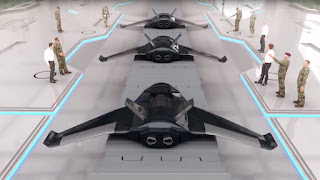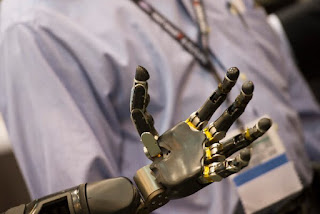ADVANCED TECHNOLOGIES IN THE DEFENSE SECTOR
In Today’s times, while all sectors have readily accepted technology, the defense sector hasn’t been left behind in the race at all. Over the years, they have been equipping themselves with the latest development and have been advancing at a great scale. The technology of war may be divided into five categories- Offensive arms harm the enemy while Defensive weapons ward off offensive blows. Transportation technology moves soldiers and weaponry; Communications coordinate the movements of armed forces Sensors detect forces and guide weaponry. ICT is an acronym for Information and Communication Technology and it has introduced a variety of transformations in the defense industry in terms of advancements in their weapons like smart weapons and management for the battlefield in network-centric superiority in air and outer space, real-time combat surveillance, etc. Artificial intelligence (AI) can bring enormous changes in the way wars are fought: Indian Air Force (IAF) chief said. The Chief of Air Staff said his force is also looking at using AI in areas of data and intelligence fusion, maintenance as well as in its decision support system. Modern warfare is warfare that is in notable contrast with previous military concepts, methods, and technology, emphasizing how combatants must modernize to preserve their battle worthiness. As such it is an evolving subject, seen differently in different times and places.

IMPORTANCE OF TECHNOLOGY IN THE DEFENSE SECTOR
The defense sector has been responsible for many groundbreaking technological advances from the internet and computers to drones and GPS. Over the years, Western nations have invested heavily in R&D in order to keep one step ahead of the adversary and gain a first-mover advantage. But today, with a combination of military budget restriction and the exponential growth of technology, companies have left defense trailing the civilian world in terms of R&D. Defense organizations need to be attuned to emerging innovations emanating from outside the defense sector and embrace them as early as possible. Some militaries already use unmanned weapon systems that can be controlled by a soldier from distance. But now, the militaries are developing systems that may allow a more hands-off approach, like an autonomous, robotic drone that accompanies manned fighter jets. Autonomous military robots with learning components may operate alongside the warfighter by 2028. For several years, the United States Army has been planning and developing it’s Multi-Domain Operation (MDO). The Army expects this to be ready by 2028 as the first step in its doctrine evolution. U.S. hypersonic missiles get faster and more operable. They are the ultimate first-strike weapon. They fly at five times the speed of sound or faster, making it nearly impossible for ballistic missiles interceptor to catch them. Despite a lot of progress in recent years, practical laser weapons that can shoot down planes or missiles is no more a future. The Laser weapon system is essentially exactly what it sounds like a ship-mounted laser cannon. The laser system allows for pinpoint target destruction of enemy assets including everything from small ordinances to enemy craft engines. It also has the advantage of being much more cost-effective and efficient when compared with traditional projectile weaponry as it only requires sufficient power to fire. Whereas missiles need to be built, transported, stored, and maintained in order to be used. Helicopters of the future technology will let pilots focus on the fight more than the flight. Emerging technology such as artificial intelligence, hypersonics, machine learning, nanotechnology, and robotics are expected to revolutionize the battlefields of the future.

DISADVANTAGES OF NEW TECHNOLOGY IN THE DEFENSE SECTOR
The Stockholm International Peace Research Institute (SIPRI) has excellent data on military spending by nations. According to its research, the five biggest spenders in 2019 were the United States, China, India, Russia, and Saudi Arabia. Together, these countries made up around 60% of global military spending. In 2019 U.S. military expenditure increased by almost 5.3% to $732 billion, China increased its military spending by 5.1%, India by 6.8%, Russia by 4.5% whereas Saudi Arabia decreased it by 16%. If these countries allocate this money to improving infrastructure, education, and health sectors rather than spending on weapons and artilleries, it will be good for mankind overall. One of the live examples we have of the consequences of technology is the detonation of atomic bombs over Hiroshima and Nagasaki in August 1945 resulted in horrific casualties. The long-term effects of radiation exposure also increased cancer and birth defect among survivors and children which was revealed by comprehensive follow-up studies. The health effects of nuclear explosions are primarily due to air blasts, thermal radiation, initial nuclear radiation, and residual nuclear radiation or fallout. Army robots could be hacked by the enemy and can be used against you. They can malfunction and turn against you or explode in front of you, they can’t tell right or wrong meaning they could kill civilians as well as rebel allies if it sees them. Robotics can’t accommodate non-standard conditions. Russia appears to have developed a nuclear weapon capable of sneaking along the bottom of the sea and detonating along the coastline to flood the area with what one official described as a “Radioactive Tsunami”. Defense experts have emphasized concerns regarding this specific superweapon of Russia known as “The Poseidon 2M39 torpedo”. It could wipe out entire cities. Leaving behind toxic radioactivity which is hazardous not only to mankind but also to the environment.
CONCLUSION
- Technological change continues at an increasing pace, especially for military technology with its widespread, institutionalized research and development. Near-future technologies include drones, robotic weapons systems, nanotechnologies of warfare, and autonomous weapon systems. We are getting advanced day by day but on the other hand, we humans are proceeding towards our own destruction about which we are not thinking much.

